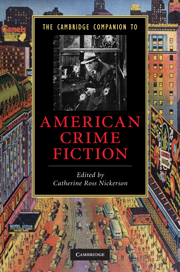Book contents
- Frontmatter
- 1 Introduction: The satisfactions of murder
- 2 Early American crime writing
- 3 Poe and the origins of detective fiction
- 4 Women writers before 1960
- 5 The hard-boiled novel
- 6 The American roman noir
- 7 Teenage detectives and teenage delinquents
- 8 American spy fiction
- 9 The police procedural in literature and on television
- 10 Mafia stories and the American gangster
- 11 True crime
- 12 Race and American crime fiction
- 13 Feminist crime fiction
- 14 Crime in postmodernist fiction
- Guide to reading
- Index
7 - Teenage detectives and teenage delinquents
Published online by Cambridge University Press: 28 September 2010
- Frontmatter
- 1 Introduction: The satisfactions of murder
- 2 Early American crime writing
- 3 Poe and the origins of detective fiction
- 4 Women writers before 1960
- 5 The hard-boiled novel
- 6 The American roman noir
- 7 Teenage detectives and teenage delinquents
- 8 American spy fiction
- 9 The police procedural in literature and on television
- 10 Mafia stories and the American gangster
- 11 True crime
- 12 Race and American crime fiction
- 13 Feminist crime fiction
- 14 Crime in postmodernist fiction
- Guide to reading
- Index
Summary
Today, in the early twenty-first century, mystery series are known as a widespread, profitable genre of children's literature. This was not always the case; while adult mystery series thrived in the late nineteenth century, mystery series for children did not appear on the American cultural landscape until the 1920s. When they arrived, they proved immensely popular. Led by the success of the Hardy Boys and Nancy Drew mysteries, which debuted in 1927 and 1930, respectively, the literature of teen detection multiplied during the period from the 1930s to the 1950s. In those same years, youth itself commanded attention in the news and entertainment media; during the course of the early to mid twentieth century, teenagers were increasingly recognized as a distinct and potent category of social identity. As this recognition developed, so did adult concerns about the separatist nature of youth culture, its tendency to develop new cultural styles and mores that opposed white middle-class standards of decency. Youth historians Joe Austin and Michael Nevin Willard, surveying the twentieth-century discourse of adolescence, have noted in it “the bifurcated social identity of youth as a vicious, threatening sign of social decay and 'our best hope for the future.'” Crime writing proved a useful venue for expressing both identities. In children's mysteries, adults wrote of teens who saved the world; in the adult-oriented genres of journalism and pulp fiction, adults wrote of teens as juvenile delinquents who augured America's doom.
- Type
- Chapter
- Information
- The Cambridge Companion to American Crime Fiction , pp. 72 - 85Publisher: Cambridge University PressPrint publication year: 2010
- 1
- Cited by



